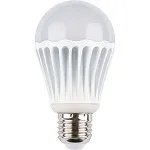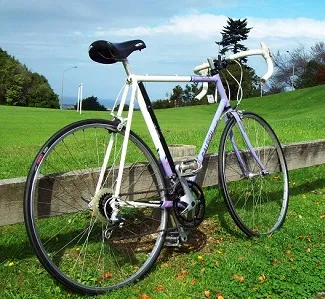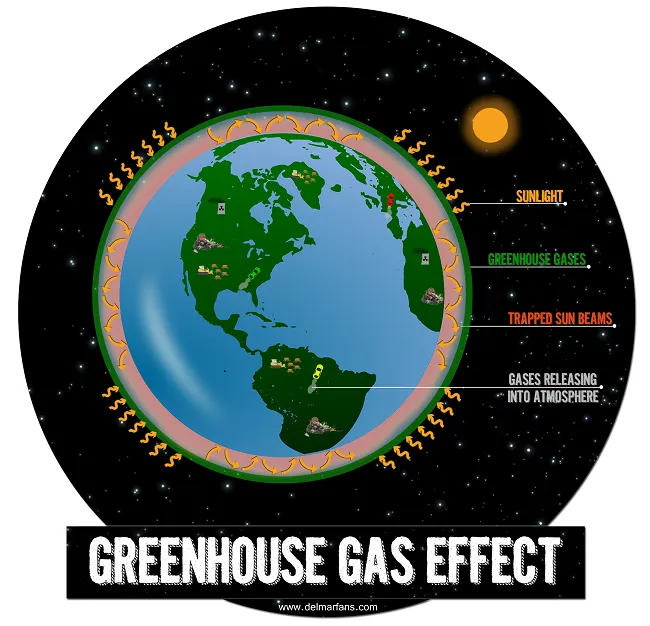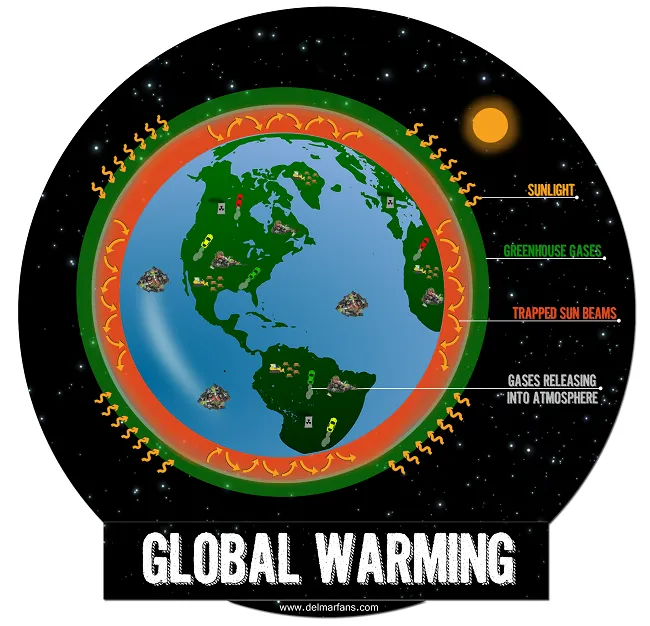Earth is estimated to be roughly 4.5 billion years old. Our atmosphere has been continually evolving ever since. An extraordinary balance of elements come together allowing life to form and thrive on this planet. It’s our legacy to protect this unique planet for future generations by reducing greenhouse gases. Learn how using these efficient lighting, fan, cutting excess, driving and gardening tips can reduce this generation's carbon footprint.
What is the greenhouse effect?
A very basic definition of the greenhouse effect is when greenhouse gases form a protective layer around the Earth that captures some of the heat rays from the sun, which keeps Earth from being a frozen planet and allows for organisms to grow.
The theory of global warming is that the more greenhouse gases we release into the air the thicker the protective layer grows, capturing more heat from the sun, ergo, Earth gets continuously warmer. Many worry Earth may one day become too warm to sustain life.
Some of the greenhouse gases include carbon dioxide, nitrous oxide, perfluorocarbons, sulfur hexafluoride, ozone, water vapor and a few others. The process of creating electricity, running cars, using landfills and making chemicals are some of the top ways we are releasing more and more greenhouse gases into the atmosphere.
The good news is, according to the Environmental Protection Agency’s (EPA) latest report, the U.S. has shown a 3.4 percent drop in emissions from 2011 to 2012 due to reduced energy consumption and switching from coal to natural as based fuels. The more we can reduce our consumption of these things the more we can diminish greenhouse gases.
1. Light Right
The best place to start saving and reducing greenhouse gases is by choosing the right lighting options for your living space or office. With so many different ways to light your home, here are our top tips.

- Get the right bulb. Light bulbs say a lot more about conservation than you may think. LEDs are the leading energy saving light bulb and can save you up the 75 percent off your home lighting. Learn more by reading our Facts About Energy Efficient Light Bulbs article.
- Turn the lights off. Whenever you leave a room in your home, make sure to turn off all the lights. Leaving a light on wastes energy. You could be losing thousands of watts of energy per month.
- Let the light in. Pull back your curtains and blinds to let more natural light in your home. This helps save a lot of energy. Also, consider adding skylights to your living space to provide natural light. This technique works well in bathrooms, offices, kitchens and garages.
- Get dimmer. Set the mood for any occasion while saving between 10 to 50 percent off your home’s lighting expenses. Lighting dimmers are easy to install and allow you to set your lights based on your needs.
- Don’t forget your outdoor lights. Remember to update the light bulbs and lighting fixtures outside of your home. Solar lighting is a great way to save energy. Also, consider putting LED security lights or LED landscape lights on a timer or a motion sensor to help prevent unnecessary usage.

2. Reduce, Reuse and Recycle
Hippocrates said it best when he said, “Everything in excess is opposed to nature.” Reduce your carbon footprint and greenhouse gases by simply cutting the excess from your routine and life.

- Shop smart. You already know using reusable grocery bags will help the environment, but did you know about Energy Star products like ceiling fans, light bulbs, appliances and lighting fixtures? We will talk more about some of those later but these products are made specially to conserve energy, thereby reducing greenhouse gases. Also, always think less is more at the store. Are you really going to need/use that?
- Turn it off. Sometimes we have a radio, TV, or computer running while focusing on something else. Ask yourself if you really need that appliance on and if not, power it down. This also pertains to faucets. Never let water run while brushing your teeth or scrubbing your face.
- Go cold. Consider washing general loads of laundry in cold water. When possible, wear clothes more than once before washing them and only washing larger loads each time. The same goes for using your dishwasher. You could consider washing smaller loads by hand. If you’re really brave, try cold showers.
- Clear the clutter. Take a box around your home and fill it with things you haven't used in three months. If it doesn’t contain a sentimental value, do you really need it? If not, have a yard sale or take it down to a local homeless shelter. Bonus, you’ll feel great about yourself.
- Before you throw that out, ask yourself these three things. Can I reuse this? Maybe you can turn it into something useful. Can someone else reuse this? Do you know someone who might need it? Can I put this in the recycle bin? The less trash in the landfills the better.

3. Become a Fan of Fans
Air conditioners (AC) and heaters use a lot of energy. While conserving electricity it’s important to consider your heating and cooling needs. Fans are great tools that can help you achieve your energy saving goals.
- Choosing the right fan for you. We recommend you consider Energy Star products. These fans meet the rigorous standards set by the U.S. Environmental Protection Agency (EPA) for saving energy. Also, consider the most important fan factors to you, including motor, style, size, finish, price and watt usage.
- Ceiling fans go a long way. Ceiling fans can save up to 75 percent off cooling costs depending on the fan. Don’t forget to reverse your ceiling fan in the winter.
- Use desk and floor fans. If you’re looking for less commitment, consider floor or portable desk fans. These require no installation and can be easily moved from space to space. You could save up to 65 percent more energy with portable fans.
- In smaller areas consider wall or low profile fans. Wall fans are easily installed in both indoor and outdoor spaces. Hugger ceiling fans work in rooms with low ceilings. Ceiling fans are recommended to be installed at least seven feet from the floor.
- Do you need an outdoor ceiling fan? Outdoor Energy Efficient fans can help to cool you during the hot summer days. If you get an outdoor fan with lights you can help illuminate parties and barbecues using energy saving LED bulbs that also help to reduce greenhouse gases.

4. Drive Less, Drive Smart
About half of air pollution comes from vehicles. With millions of cars currently on the road and the number growing every year this comes as no surprise. Drive less to reduce greenhouse gases.
- Car pool or ride public transit. Get a car pool going at your job or map out your local bus/subway system. Keeping cars off the road helps bring drive time and car idling down, especially during peak driving hours. You will save money on gas and car maintenance.
- Walk or ride your bike. If your destination is a reasonable distance from your home consider riding your bike or simply walking. You will save the environment from greenhouse gases and get some great exercise.
- Get your car maintenance regularly. Keeping your car in top shape will help prevent leaks, fires, gases from accidents and unnecessary exhaust from escaping into the atmosphere. You should get your car serviced at least once a year, plus regular oil changes every 5,000 miles.
- Consider an energy efficient car. Hybrids can save you major money on gas and on tax credits. You will also be cutting down greenhouse gas emissions by more than half depending on the model you choose.

5. Use Your Green Thumb
The more people growing their own plants, food and trees, the higher amount of greenhouse gases we can eliminate from the air. A food mile represents a mile which the food has to be transported from producer to consumer, some foods have huge food miles. These miles are often made by large semi-trucks that release a multitude of chemicals into the atmosphere.
- Get your garden on. Growing your own foods are an excellent way to eliminate food miles. Visit the Farmer’s Almanac for help with free gardening plans and information about plants currently in season.
- Plant shade trees. Trees convert carbon dioxide into oxygen allowing us to breathe. Shade trees can help keep your home cooler in the summer allowing you to use your AC less.
- Use scraps in your garden. Composting your old food can keep your garden’s soil rich and vibrant. Composting helps suppress disease and weeds.
- Make your own household chemicals. There are so many different recipes online for safer, less toxic cleaning chemicals that you could make and be using in your home.
- Buy local. Consider buying locally grown products at farmer’s markets or other smaller stores. You can save on food miles and these products are often cheaper.






